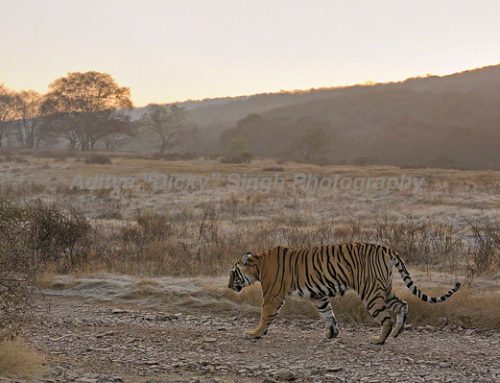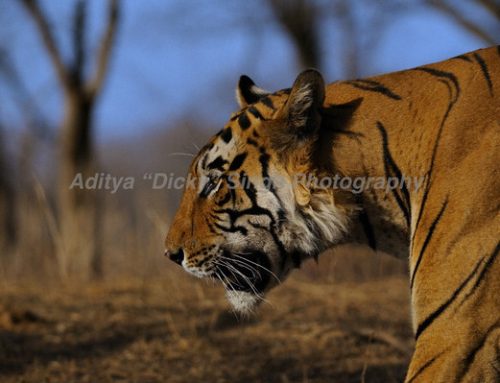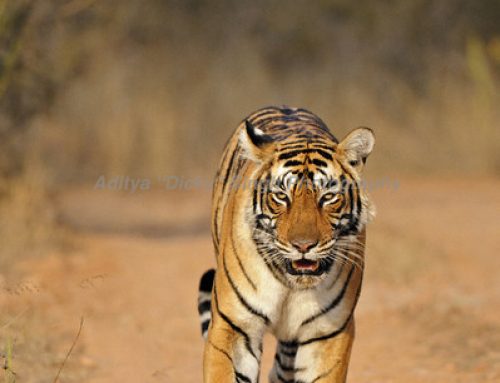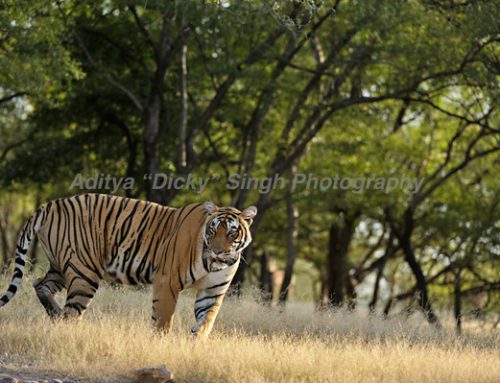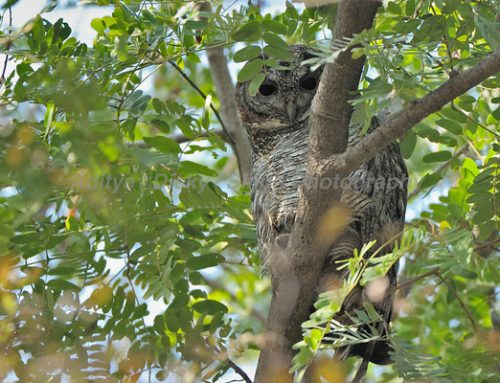
Machali or T 16 was born sometimes during the monsoons of 1997. She was the dominant cub amongst a litter of 3 females. I moved to Ranthambhore in 1998 and she was one of the first cubs that I saw in Ranthambhore. Since then I have had a strong emotional attachment to her. Machali in Hindi means “fish”. She was initially known as the “Jhalara tigress” after an area called Jhalara, which was the heart of her initial territory. A BBC documentary “renamed” her Machali, originally the name of her mother. Her mother was called Machali (or fish) because she had a mark on her right cheek that took the outline of a fish. The “present” Machali or T 16 has a mark on her left cheek that resembles and outline of a table fork. (see picture below).
By the end of 1998, Machali and her two sisters had separated from their mother and had established their independent territories. Machali started off with a small part of her mother’s territory and gradually expanded it to include all the three lakes, a large part of Mandoop plateau, Lakkarda and adjoining areas. She soon had the largest territory of all the female tigers in Ranthambhore. (Highlighted area in map below)
Sometimes in the end of summers 2000, Machali gave birth to a liter of two male cubs – called Broken Tail and Slant Ear. “Bamboo Ram” who at that time was the largest and the most dominant male tiger of Ranthambhore sired them. By the end of 2001 both Broken Tail and Slant Ear had separated and Slant Ear was never seen again. Broken Tail initially survived at the edge of the national park and in the summers of 2003 he moved on to another forest almost a 100 miles away, where a passenger rain ran him down in August 2003.
Soon after Broken Tail and Slant Ear separated Machali mated again with a male tiger called “Nick Ear” who had taken over Bamboo Ram’s territory after Bamboo died of old age. I saw Machali with three small cubs in pouring rain, one of which she was carried in her mouth on the 30th June 2003, on the last safari before the park was closed for the monsoon rains. She was taking them away from a cave in a place called Nalghati, where they were born, to higher ground, as this area is prone to flooding. When the park re-opened after the monsoon months in October we saw just two of these three cubs – a male called Jhumroo and a female called Jhumree.
Ranthambhore experienced a severe drought during 2004 and 2005, when most of the waterholes in the park dried out, including two of the three lakes. This was the time when Jhumroo and Jhumree were coming of age. During these two year Machali had some spectacular interactions with crocodiles around the dried or drying lakes and in all of these interactions the crocodiles ended up dead. By the end of summers of 2004 even Jhumroo was killing and eating crocodiles. However, such interaction with crocodiles did take a toll on Machali and by 2005, when she was nearly 8 years old she had lost two of her four canines. We were getting worried about Machali’s ability to hunt larger prey but she proved us wrong. By the beginning of 2005 Machali turned aggressive towards Jhumree and pushed her off to one fringe of her territory. We never saw her again. Soon after she pushed Jhumroo out of her territory and Jhumroo mover on to an area called Lahpur, where he still reigns.
Around March 2005 Machali gave birth to a third set of litter of one male and one female cub, called Bahadur (brave in Hindi) and Sharmelee (shy in Hindi). Their father was a male called the T 2 or X male (so called because we knew very little about him and he was hardly ever seen). Till now Machali had brought most of her cubs up on Sambar deer kills that were made mostly in the tall grasses at the edge if the lakes or in the many dry stream beds that were found in her territory. While bringing up her third and fourth litter she showed a preference for smaller sized prey, especially deer fawns, that were easier to kill. At that time we thought that she was avoiding large sized prey because she had lost two of her canines but this was not true, as we learnt later on. She was going for deer fawn because they were easy to kill and they were plentiful, after the end of the long drought. Bahadur is till in the park, while Sharmelee was one of the first tigers to be “relocated” to Sariska tiger reserve, after Sariska lost all its tigers to poachers. I took to serious photography around the same time when these cubs were born.
During the summers of 2006, Machali, to our surprise, gave birth to her fourth litter of three female cubs – called T 17, T 18 and T 19. Like her third litter, X male also sired these three cubs. When the cubs were small Machali would not let Sharmelee come even close to them but she tolerated Bahadur. Bahadur was often seen sitting calmly close to Machali and her three new cubs, while Sharmelee was almost always chased away by Machali. For the next two years Machali and her three cubs delighted visitors to Ranthambhore. These three cubs stayed on with their mother for nearly two full years and it was only in the summers of 2008 that they started separating. While T 17 and T 19 carved out the bulk of Machali’s territory between them, leaving only a small area in Lakkarda for Machali, T 18 established herself in Phoot Kot just outside the southern edge of Machali’s territory. Soon T 18 was also “relocated” to Sariska.
From 2009 till now Machali has survived in a small territory in Lakkarda where she still lives. The territory may be small but it has a few permanent water holes, many places to hide (cover) and lots of prey – all that a tiger need to survive. Machali is a survivor.








